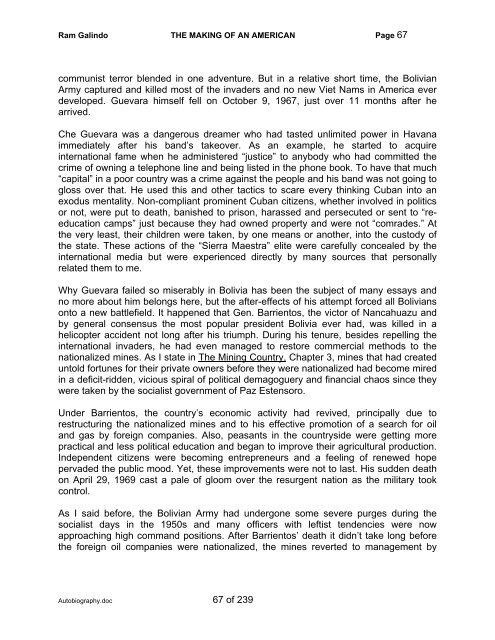Autobiography - The Galindo Group
Autobiography - The Galindo Group
Autobiography - The Galindo Group
Create successful ePaper yourself
Turn your PDF publications into a flip-book with our unique Google optimized e-Paper software.
Ram <strong>Galindo</strong> THE MAKING OF AN AMERICAN Page 67<br />
communist terror blended in one adventure. But in a relative short time, the Bolivian<br />
Army captured and killed most of the invaders and no new Viet Nams in America ever<br />
developed. Guevara himself fell on October 9, 1967, just over 11 months after he<br />
arrived.<br />
Che Guevara was a dangerous dreamer who had tasted unlimited power in Havana<br />
immediately after his band’s takeover. As an example, he started to acquire<br />
international fame when he administered “justice” to anybody who had committed the<br />
crime of owning a telephone line and being listed in the phone book. To have that much<br />
“capital” in a poor country was a crime against the people and his band was not going to<br />
gloss over that. He used this and other tactics to scare every thinking Cuban into an<br />
exodus mentality. Non-compliant prominent Cuban citizens, whether involved in politics<br />
or not, were put to death, banished to prison, harassed and persecuted or sent to “reeducation<br />
camps” just because they had owned property and were not “comrades.” At<br />
the very least, their children were taken, by one means or another, into the custody of<br />
the state. <strong>The</strong>se actions of the “Sierra Maestra” elite were carefully concealed by the<br />
international media but were experienced directly by many sources that personally<br />
related them to me.<br />
Why Guevara failed so miserably in Bolivia has been the subject of many essays and<br />
no more about him belongs here, but the after-effects of his attempt forced all Bolivians<br />
onto a new battlefield. It happened that Gen. Barrientos, the victor of Nancahuazu and<br />
by general consensus the most popular president Bolivia ever had, was killed in a<br />
helicopter accident not long after his triumph. During his tenure, besides repelling the<br />
international invaders, he had even managed to restore commercial methods to the<br />
nationalized mines. As I state in <strong>The</strong> Mining Country, Chapter 3, mines that had created<br />
untold fortunes for their private owners before they were nationalized had become mired<br />
in a deficit-ridden, vicious spiral of political demagoguery and financial chaos since they<br />
were taken by the socialist government of Paz Estensoro.<br />
Under Barrientos, the country’s economic activity had revived, principally due to<br />
restructuring the nationalized mines and to his effective promotion of a search for oil<br />
and gas by foreign companies. Also, peasants in the countryside were getting more<br />
practical and less political education and began to improve their agricultural production.<br />
Independent citizens were becoming entrepreneurs and a feeling of renewed hope<br />
pervaded the public mood. Yet, these improvements were not to last. His sudden death<br />
on April 29, 1969 cast a pale of gloom over the resurgent nation as the military took<br />
control.<br />
As I said before, the Bolivian Army had undergone some severe purges during the<br />
socialist days in the 1950s and many officers with leftist tendencies were now<br />
approaching high command positions. After Barrientos’ death it didn’t take long before<br />
the foreign oil companies were nationalized, the mines reverted to management by<br />
<strong>Autobiography</strong>.doc 67 of 239


